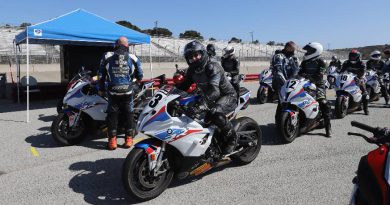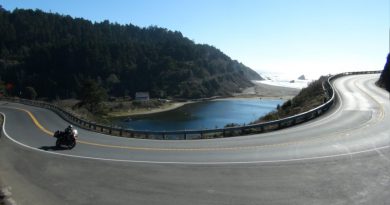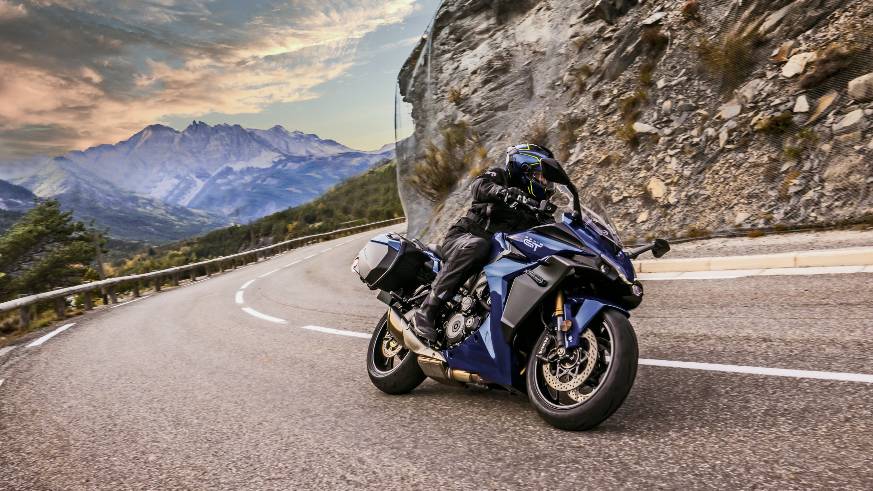
What to Know About ECU Flashing
Hidden under the fairings of your sport touring motorcycle lies an electronic marvel that can best be described as an ever present, always rational, never flustered, copilot. A device that listens to throttle inputs and then translates them into signals that control engine performance. This amazing device is known as the Engine Control Unit or ECU for short. In fact, the ECU, not the rider, has the final say about throttle response. Which is why experienced riders seek-out ECU modifications to put more of that control directly in their hands.
This article explains how to go about modifying your ECU safely and what to consider before going ahead. To get a complete picture, we spoke with several major tuners, and had an in-depth conversation with Nate Phipps at 2 Wheel DynoWorks. For balance, we also listened to feedback from riders. (Just a reminder, American Sport Touring does not accept endorsement fees or compensation of any kind from those who contribute.)
Six Key Takeaways
- Re-tuning the ECU is a must when running aftermarket exhaust or air intake systems to adjust fuel mixture to match improved airflow.
- Carefully choose your ECU tuner, they are not all the same and the outcome depends on multiple factors, not the least being competency and experience. Call and talk to at least two tuners before going ahead.
- Expect smooth throttle response and predictability across the power band, longer engine life, lower operating temperatures, and yes more horsepower.
- If an ECU tuning option is not available for your motorcycle, then the best fallback is to install a piggyback module such as a Power Commander from Dynojet or the EVO from Rapid Bike. These devices improve fuel delivery, but do not alter ECU mapping tables, consequently overall performance improvements are limited.
- The cost to reflash an ECU is between $250 and $350; the cost to install and dyno tune a piggyback module like Power Commander can run $700 to $800 on top of the cost of the module itself.
- Before going ahead with any modifications, carefully consider any impact on your motorcycle warranty and emissions compliance. Most ECU tuning is intended for track use and likely to leave your bike out of compliance with emissions regulations.
Why Tune Your ECU
The impulse to tune an ECU starts with a desire for more horsepower. And tuning can deliver that. But there are more important reasons to “flash” an ECU.
First, let’s acknowledge that factory engineers are quite capable of producing motorcycles with extraordinary power and performance if left on their own. Unfortunately, engineers don’t work in isolation. Instead, they are constrained by emission standards, fuel economy targets, and sales considerations like rideability and safety. Consequently, factory engineers are compelled to make compromises here and there to create a bike with both respectable street manners and regulatory compliance. Many of these compromises show up in the ECU.

A tuned ECU can resolve common performance problems:
- Throttle Lag – A feeling of hesitation between wrist movement and engine response that leads to sloppy gear changes, particularly when downshifting.
- Improved Airflow – If your bike has an aftermarket exhaust system, even a slip-on exhaust, then the ECU should be re-mapped. Same applies if changes were made to any part of the air intake system. Engines operate as a unit, to move air from intake to exhaust, creating power in the process. Factory ECU programming is designed to deliver the right fuel and air mixture along with optimal ignition timing to match the factory air intake and exhaust set-up. Changing any part of the system without remapping the ECU to compensate defeats the purpose and ironically can even degrade engine performance and longevity.
- Wider Power Band – An ECU tuner, unlike factory engineers, has the freedom to alter virtually all ECU parameters – fuel, ignition, throttle – to safely extract as much horsepower and torque from the engine as possible.
Beyond solving these common problems, a tuned ECU will deliver better fuel economy, reduce engine operating temperatures, and remove factory imposed speed limiters and other settings to suite a rider’s individual preference.
ECU Tuning Fundamentals
A basic understanding about how an ECU works is helpful background to have before going down the tuner path.
Tuning the ECU is the only way to get around factory imposed constraints. However, such changes are highly technical. Once inside an ECU, there are no safety rails. Incorrect settings can make an engine run poorly and in the extreme not run at all. Which is why this work is best left to experienced tuners.
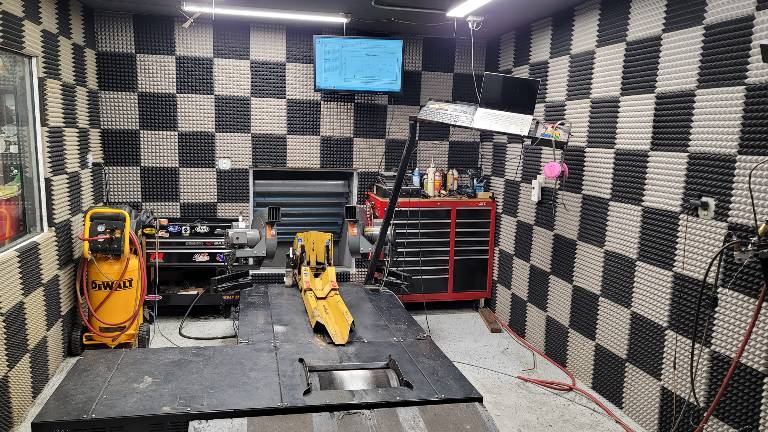
The Engine Control Unit is only one of several control units on a modern motorcycle. In addition to taking input from the rider’s wrist, the ECU also receives signals indicating lean angle and acceleration from the Inertial Measurement Unit, traction control system input, and in some cases ABS signals to name a few. The ECU monitors these signals and tempers throttle input to increase rider control and safety.
The ECU manages engine performance by constantly comparing these signals with pre-determined values stored in look-up tables (often called mapping tables or maps) that conceptually look like values plotted on an X/Y axis where each axis represents an input signal. For example, the ECU fuel tables plot throttle position on the X axis and RPM on the Y axis. For any given RPM signal and throttle position the ECU logically moves down the RPM axis (Y) to the corresponding RPM value, then moves across the throttle input axis (X) to the value corresponding to throttle position. At that intersecting point it finds a fuel mixture parameter. The ECU runs this value and other relevant signals through an algorithm resulting in a control signal to send to the fuel injectors.
Modern sport bikes have dozens of mapping tables. The ECU in the latest BMW S 1000 RR, the most advanced street bike on the market today, utilizes over 400 tables.
Nate Phipps, 2 Wheel DynoWorks
These mapping tables are an ECU tuner’s playground. Tuners do not directly alter ECU algorithms, instead they influence algorithm outcomes by modifying input parameters taken from revised mapping tables. It’s an indirect approach to be sure, and consequently one that takes trial and error to get right.
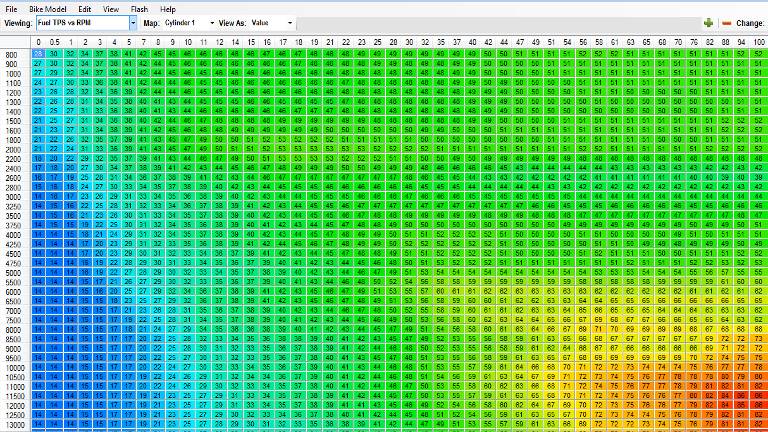
Trial and error means many, many dyno runs. Tuners use both dynamometers and data loggers to collect a complete engine performance baseline. Then they start methodically making ECU changes based on experience and a deep understanding of the variables involved. Each set of changes is followed by another dyno run and logging exercise. Eventually the tuner arrives at a point where further changes have a negative effect. That’s when they know the last tune was as good as it gets, while still leaving a tolerance for exceptions like a bad tank of gas.
Engine performance on bikes flashed with an ECU tune from 2 Wheel DynoWorks deliver +/- 2% of the same performance measurements as the original test bike.
Nate Phipps, 2 Wheel DynoWorks
At 2 Wheel DynoWorks, a final ECU tune is not ready for distribution until it passes multiple road tests with different riders who bring track experience to evaluate actual ride quality. Only then does the tuner have reliable mapping tables for the test bike. But that’s only one make and model. Tuners repeat the entire process for each motorcycle make and model they intend to support. On top of that, they need to retest mappings in response to annual model updates. It is a tedious and painstaking process.
Power Commander Alternative
ECU tuning is a significant modification, and some riders are reluctant to go that far. Enter the Power Commander from Dynojet or EVO from Rapid Bike. These popular devices are much less intrusive and relatively easy to install. Piggyback modules are wired into the motorcycle between the ECU and the fuel injectors. They intercept the ECU fuel mixture signal and replace it with a revised signal based on their own fuel map. The ECU is none the wiser.
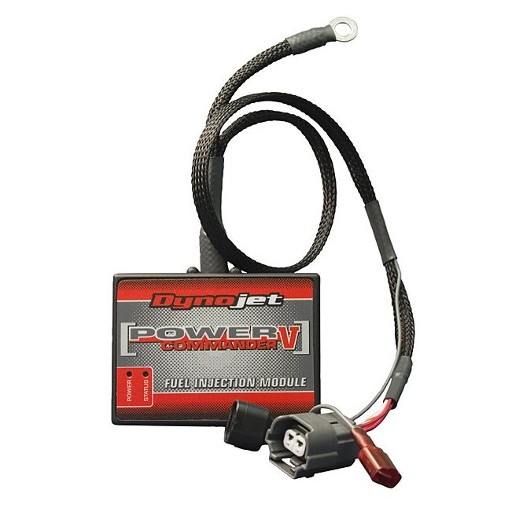
These devices are a quick solution to enrich the fuel mix after installing a full performance exhaust system or increasing air intake. However, because of their piggyback design they cannot achieve the same level of performance as a tuned ECU.
Finding an Experienced ECU Tuner
ECU tuning is not a DIY process. Removing and reinstalling an ECU can be done by anyone with basic skills, but flashing an ECU is another thing. Selecting the right mapping values and related settings is a more intricate task best left to experts. Even companies that make flash tuning kits, such as FlashTune, point customers to partner shops with proven expertise.
Expert tuners use dynos and data loggers. They understand the relationship between various mappings and have the expertise to dial them in for the best overall performance. Finding an optimal combination can take hundreds of runs.
On top of that, there is no best answer in this business. That’s because the resulting performance characteristics are once again a compromise between competing variables. Every tuner finds his or her own balance. Some strive to get every bit of power from an engine, while most focus on throttle quality. A good tuner can deliver the best of both.

It’s important to talk to your tuner. Let him or her know what you like and don’t like about your bike’s performance. Is the throttle twitchy in low gears, laggy on shifts, unresponsive out of corners? Don’t forget to mention any engine modifications. Does the bike have aftermarket air intake or exhaust components? Any internal engine performance parts? Tuners ask lots of questions to guide their work.
Finding a competent and trustworthy ECU tuner can be challenging. A web search will uncover both tuners and tools. The best approach is to read the forums for your make and model. Often someone has already had the work done and posted feedback. Local dealers and performance shops are another resource. Not all tuners work on all models so a well-reviewed Hayabusa tuner may not show up in an FJR forum. Make some phone calls, explain what you are trying to accomplish, and then decide.
In the event you happen to have a bike for which no one offers ECU tuning, then consider one of the piggyback devices mentioned earlier. At a minimum these devices improve fuel delivery to balance aftermarket modifications. More advanced units can also adjust airflow and timing. If you take this approach, consider working with a tuner to install reliable maps for your motorcycle configuration.
Is ECU Tuning Worth It?
In a word, yes. Manufacturers build motorcycles for the masses, with each bike designed for a particular riding style. And in every case, a bike’s true potential is limited by competing regulatory and business concerns resulting in something less. Whether you have a sportbike, sport tourer, or touring bike – its real performance potential is hidden behind an ECU that was factory tuned for – well – the average rider. And since no one is that average rider, no bike will feel like a perfect fit.
As one rider we spoke with told us; “it wasn’t a mega horsepower change, just smoother and more responsive throttle for better sport riding.”
Hiring a tuner is an indulgence in motorcycle performance. Tuners take good bikes and make them better – more controllable, more predictable, and more reliable. And a little faster too.
[placeholder text]
Your response is used by American Sport Touring only, we do not store or sell your information.
Please read our Privacy Policy.

by John DeVitis, Editor and Publisher
John DeVitis, Editor & Publisher of American Sport Touring, has spent years riding and writing with a focus on long-distance, performance-oriented motorcycling. His time on the road has revealed little-known routes across the United States and Canada, along with practical insights into the bikes, gear, and techniques that matter to sport touring riders. He draws on this experience, together with a background in digital publishing, to guide the editorial principles and clear vision behind American Sport Touring, delivering content riders can trust.

